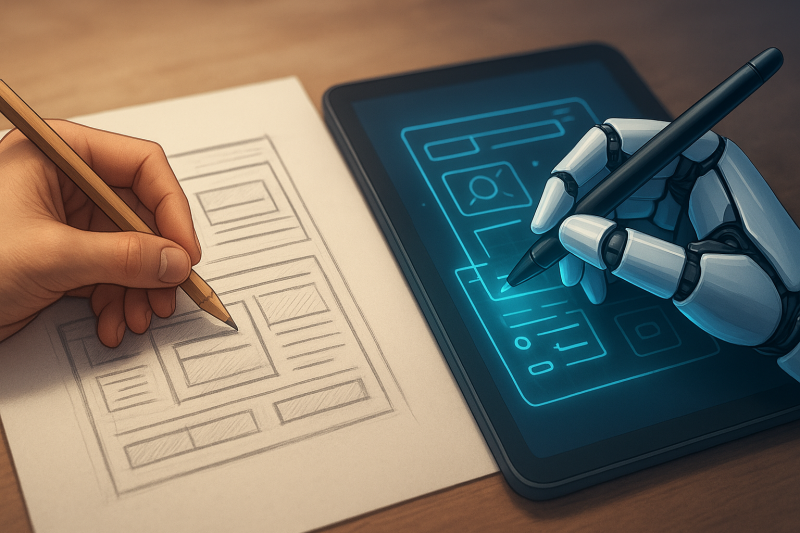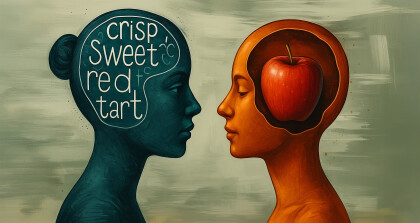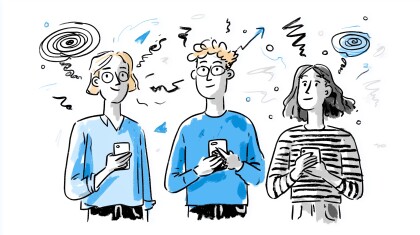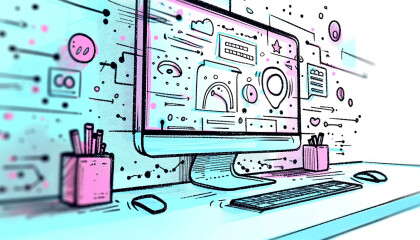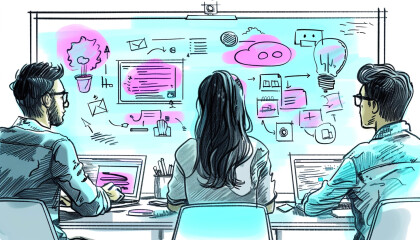I'll be honest with you. The first time I used AI for design work, I had a little chuckle to myself.
The output was clumsy. Too literal. It had the look of something that “might” work, but felt a bit off. But then something unexpected happened. I felt a bit uneasy. Because even though the results weren't perfect, they were fast. And that made me stop and think.
If AI can already do this, what happens when it gets better?
That was the wake-up call.
Like many of you, I've been figuring out how to live and work with AI by becoming more AI literate. Learning enough to understand how it works and how to use it with intention. And along the way, I've discovered something important. AI isn't here to replace us. It's here to change how we work.
AI Tools for Designers: Streamlining Research & Design
Let's start with the practical.
Every designer knows how much time research takes. Hours of reading feedback. Sorting surveys, listening to interviews, and turning messy notes into neat insights. It's important work, but it's heavy.
This is where AI shines.
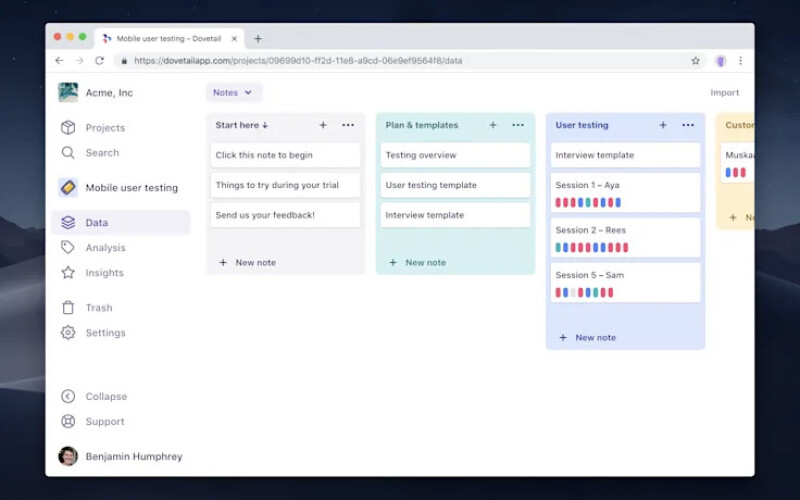
Tools like Dovetail and Maze are already clustering themes for us. Pulling out trends. Spotting patterns across hundreds of reviews. They can even summarise and categorise what customers are saying in a way that makes the big picture clear. What used to take days might now take hours.
Does that mean research skills don't matter anymore? Of course not. It means we get to spend less time sorting and more time thinking.
The same goes for design ideas. AI can sketch out rough drafts, spin up different layouts, or throw new ideas into the mix. It's like having a junior teammate who's always available. They're not perfect. They don't always "get it." But they keep the momentum going.
One of my favourite workflows is to use tools like V0, Loveable, and Figma Make to prototype and explore ideas. In many ways, AI feels like the new wireframe. Fast, flexible, and great for testing directions before committing to polish.
But here's the catch: the quality of what AI gives you depends on the quality of what you ask. Prompting is a skill. You need to set the stage, give context, set the rules, and show examples. The clearer you are, the better the results.
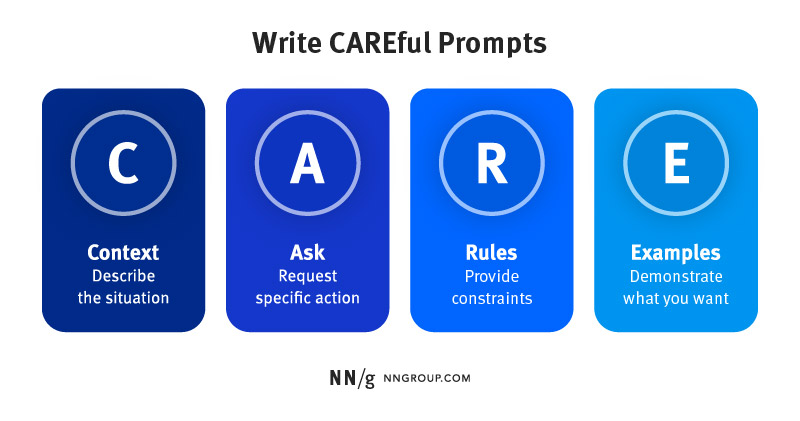
The C.A.R.E Method: A Framework for Better AI Prompts
I wish someone had taught me this when I started. There's actually a simple framework that makes prompting way more effective: C.A.R.E.
Context - Describe the situation. Don't just ask for "a login screen." Tell the AI you're designing for a healthcare app where trust and accessibility matter more than flashy animations.
Ask - Request specific action. Instead of "make this better," try "redesign this checkout flow to reduce cart abandonment for mobile users."
Rules - Provide constraints. "Keep it under 3 clicks," or "follow Material Design guidelines," or "make it work for users with low vision."
Examples - Demonstrate what you want. Share screenshots of designs you admire, or describe patterns that work well in similar contexts.
Here's the difference it makes. Instead of: "Create a user onboarding flow"
Try: "I'm designing onboarding for a budgeting app used by college students who are often distracted and sceptical of financial apps. Create a 3-step onboarding flow that builds trust without overwhelming them. Keep each step under 20 words of copy. Think Duolingo's playful approach, but for money management."
See the difference? The second prompt gives the AI something to work with.
So, is AI stealing the fun stuff? Not really. It's clearing the clutter so we can focus on what matters most.
Designing for AI: Following Proven Frameworks
Using AI is one thing. Designing for AI is another.
More and more, the products we build have AI baked in. Recommendations. Predictions. Conversations with a chatbot instead of clicks on a button. Sometimes the AI isn't even visible at all. It just works quietly in the background.
That changes the rules.
We can't just design screens anymore. We need to design for trust. People need to know what the AI is doing, why it's doing it, and how much control they really have.
The good news? We're not flying blind here. Companies like Google have developed the People + AI Research (PAIR) guidelines that focus on human-AI collaboration. Microsoft's HAX (Human-AI eXperience) toolkit gives us practical ways to design AI interactions. IBM's design principles for AI emphasise transparency and user control.
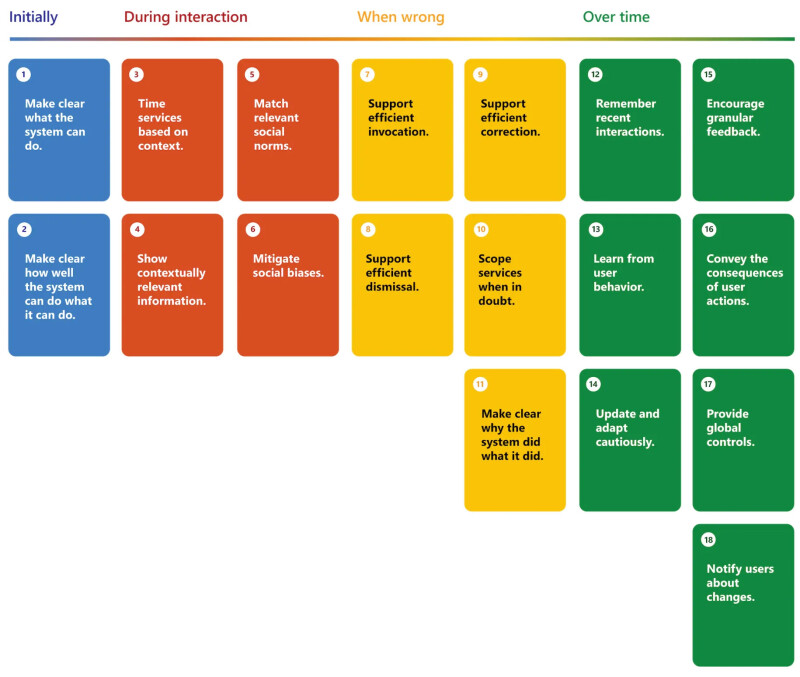
These frameworks all point to the same core questions:
- How do we explain what's happening in plain language?
- How do we give people control without overwhelming them?
- How do we make sure privacy and ethics are built in from the start?
But here's what the frameworks can't capture: the subtle art of making someone feel comfortable with AI. When a recommendation feels helpful versus creepy. When automation feels magical versus out of control.
This is where designers matter more than ever. We're the bridge between a powerful technology and the humans who have to live with it.
AI and UX Design: How Human Empathy Still Matters in an Automated World
I really like this quote that Steve Arnold, Head of Design at Phocus, recently shared:
“AI can read the data. But it can't read the room…”
Think about it. Machine learning algorithms excel at pattern recognition. They can predict which button someone might click based on millions of similar interactions. But they miss the moment when someone pauses, frustrated, trying to figure out what went wrong.
They can generate ten versions of a layout based on successful designs, but they don't know which one feels right for this specific person, in this specific moment, with this specific problem.
That's our job.
Design has always been about empathy. About listening. About seeing the world through someone else's eyes. And that hasn't changed.
If anything, it matters more now. Because when everything is faster and more automated, the thoughtful touches become the things that stand out.
A kind interaction. A moment of clarity. A design that makes someone feel understood. Those are things AI can't fake.
That's why I believe the future of UX design isn't about efficiency alone. It's about meaning.
The Evolution of Design Technology: Learning from History
Every major technological shift brings the same question.
When personal computers arrived in the 1980s, people wondered if designers would still need to understand typography and layout. When the web took off in the mid-90s, traditional graphic designers worried about relevance. The mobile revolution of the late 2000s made everyone question desktop-first thinking.
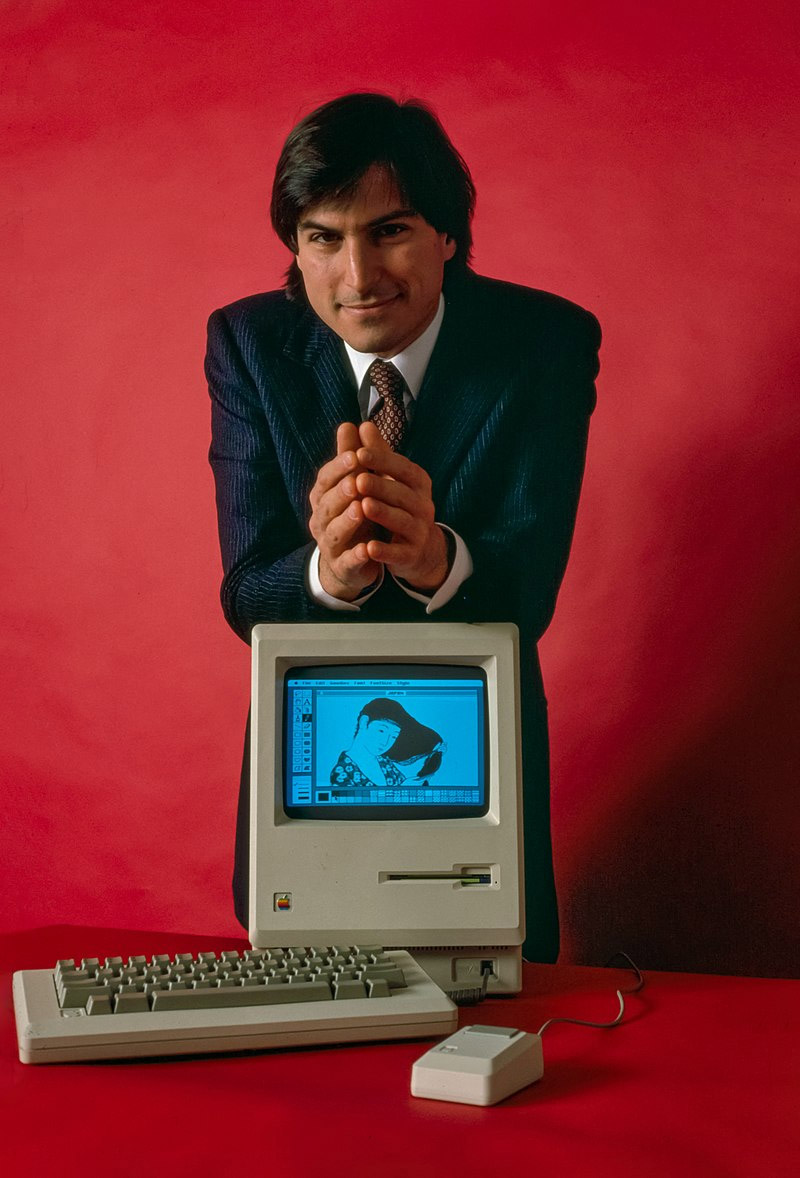
Each transition took time. Desktop publishing didn't happen overnight, it took nearly a decade for designers to fully embrace digital tools. The shift from print to web design happened in waves throughout the late 90s and early 2000s. Mobile-first design became mainstream gradually, from the iPhone's launch in 2007 to responsive design becoming standard practice around 2012-2014.
But here's the pattern. Each time, design became more important, not less. New constraints created new possibilities. New tools opened new creative territories.
AI is following the same trajectory, just faster.
The World Economic Forum's Future of Jobs Report confirms what we're seeing. While routine tasks become automated, the skills that really matter, creativity, problem-solving, and empathy, are actually growing in value. The report specifically highlights that jobs requiring uniquely human skills will see increased demand through 2028.
There will be new roles too. AI experience designers. Conversation architects. Trust and safety designers. Some we can't even imagine yet. That's how technological evolution works.
Designers are not going to be replaced by AI. But choose to ignore it, and a designer using AI might replace you.
Getting Started: AI Tools for UX Designers
Here's what I've been learning in my own practice:
Build your AI design toolbox. Start with the basics. Try Figma AI for design variations. Use ChatGPT for content strategy and user research analysis. Experiment with Midjourney or DALL-E for concept exploration. Play with GitHub Copilot if you do any front-end work. Find out what they can (and can't) do for you.
Master the art of prompting. This is becoming as important as knowing keyboard shortcuts. Be specific about context. Share examples of what you want. Set constraints and parameters. Think of it as briefing a junior designer. The clearer you are, the better the results.
Design for AI transparency. Always ask: would I feel comfortable if this were my data, my choice, my experience? Build in explanations. Show confidence levels. Give users control over automation. Make the AI's reasoning visible when it matters.
Keep empathy at the centre. Don't let speed replace care. Use AI to handle the routine work, then invest that saved time in understanding your users better. People don't remember the AI; they remember how your design made them feel.
Stay curious about AI and design trends. The tools are changing every few months. Follow AI design communities. Test new features as they launch. Keep your mind open to new possibilities, but don't chase every shiny object.
Common FAQs on AI for Designers
Will AI replace UX designers? No. It might replace some tasks, but not the human skills of empathy, creativity, and judgment. If anything, these skills become more valuable as AI handles routine work.
What's the best way to start using AI in UX design? Start small. Use it to help with research synthesis or idea generation. See where it saves you time and where you still need to step in. Don't try to revolutionise your entire process overnight.
What are the biggest risks of AI in design? Bias in AI outputs. Privacy concerns with user data. Over-reliance on AI suggestions without human judgment. A false sense of confidence in outputs that aren't quite right. That's why human oversight and ethical frameworks matter.
How do I explain AI features to users? Focus on benefits, not technology. Instead of "powered by AI," explain what it actually does for them. "Learns your preferences" or "suggests relevant content" is clearer than "uses machine learning algorithms."
Where is AI design heading in the next few years? Toward more personalised, conversational interfaces. Better integration between AI capabilities and human needs. New job roles focused on AI experience design. The key is to lean in and learn rather than wait and see.
The Heart of It All
Here's what I've come to believe.
"Powered by AI" isn't a value proposition. It's just a label. The real value comes from what we do with it.
If we use AI to speed things up but lose our sense of empathy, we've missed the point. If we use AI to cut corners but not to create clarity, we've failed the people we're designing for.
But if we use it to free ourselves from the noise… if we use it to focus more on purpose, trust, and care… then AI can actually make design more human, not less.
And that's why I'm hopeful.
Because yes, everything changes. The tools, the workflows, the platforms. But one thing doesn't change: design is about people. And that will always matter most.

